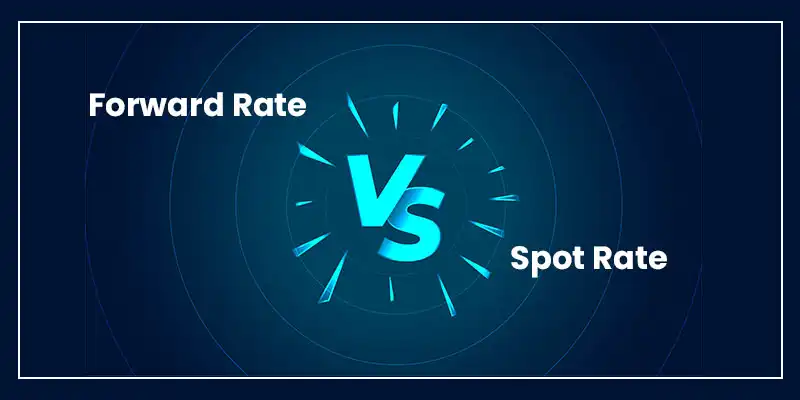Understanding interest rate structures is critical for financial professionals, especially when evaluating bond yields, currency trades, or hedging strategies. This article explains the difference between forward rates and spot rates, covering core concepts, how they’re used, and the implications of each in real-world markets.
Contents
- What is a Spot Rate?
- What is a Forward Rate?
- Key Differences Between Spot and Forward Rates
- Practical Applications in Finance
- Risks and Considerations
- Conclusion
- FAQs
What is a Spot Rate?
A spot rate is the interest or exchange rate relevant to the instant transaction settlement. Usually, within two business days, it shows the price or yield of a financial instrument, which includes a bond or currency pair, for delivery or settlement now.
Geopolitical events, economic data releases, or liquidity concerns could influence currency exchange transactions at spot prices.
For instance, if the USD/INR spot rate is 83.25, you would receive this rate if you exchanged today.
Risk Disclaimer: Exchange rates can be erratic, and depending on present rates, without risk analysis, could cause financial losses.
What is a Forward Rate?
A forward rate is an interest rate or exchange rate set today for a transaction happening at a future date. It represents market expectations of future rates and is generated from the spot rate and the yield curve.
Forward rates are not forecasts but represent the indicated expectations of future market conditions.
Actual market conditions could vary significantly from forward rate estimates, affecting results.Consider stating that forward rates are derived using interest rate parity in forex and bootstrapping techniques in bond markets.
For example, if the 6-month forward rate for USD/INR is 84.10, we have decided to convert dollars into rupees at that rate six months from now.
Risk Disclaimer:Entering into forward contracts could lead to opportunity loss if future spot rates become more favourable than the agreed forward rate.
Differences Between Spot and Forward Rates
The spot rate is the present market price or interest rate at which a financial transaction, such as a bond trade or currency exchange, is settled instantaneously. It shows the state of the market in real time. On the other hand, the forward rate is a future-dated rate set today for a transaction that will take place later. It is determined using present spot rates and interest rate spreads. Forward rates are used for hedging or forecasting on future movements; spot rates are used for instant implementation.
Spot rate = current rate
Forward rate = implied future rate based on current spot + yield differentials
Risk Disclaimer:Both carry market risk and should be utilised with educated judgement.
Read Also: Understanding Derivatives Chain and Trading in Futures & Options: Concepts and Caution
Practical Application in Finance
There are several practical applications of forward and spot rate in finance:
- Currency Hedging:Companies hedge against currency risk by using forward rates to lock in exchange rates for future transactions.
- Interest rate forecasting: Analysts deduce market expectations of interest rate changes using forward rates.
- Bond Pricing:Spot and forward curves assist in pricing fixed income instruments and computing yield to maturity.
- Derivatives:Many financial derivatives value and settle using future rates.
Risk Management and Considerations
Risk management is crucial for both the rates.
- No guarantee:Theoretical forward rates could vary greatly from actual future rates.
- Market Movements: Spot rate movements might harm forward contracts if positions are not properly hedged.
- Counterparty Risk: The danger of default in over-the-counter (OTC) contracts has to be considered.
Read Also:Options Trading Strategies for 2025: Key Approaches & Market Trends
Conclusion
Financial analysis and risk management both rely on both spot and future rates as vital instruments. Spot rates reflect current market prices, while forward rates are implied future prices derived from current data.A good knowledge of both helps companies, investors, and traders make better-informed choices.
Disclaimer
This material is meant to educate and inform; it should not be taken as financial advice. Involve risk and might not be appropriate for every investment, forward and spot rate products. Before deciding on trades or investments, always talk to a qualified financial counsellor. Past performance does not guarantee future outcomes.
FAQs
Forward rate = [(1 + shorter-term spot rate)ᵐ / (1 + longer-term spot rate)ⁿ]^(1/(n–m)) – 1].For forex, the formula would involve interest rate parity.
The future rate shows interest rate differentials, inflation predictions, and other market forces influencing the value of money or currencies over time.
Certainly, anyone can get forward contracts via brokers or currency service providers; usually, however, institutions employ them.

